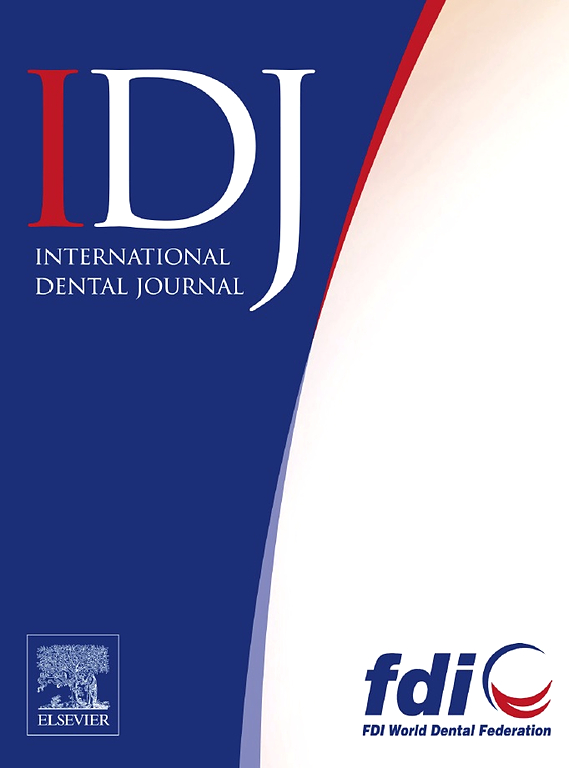尼日利亚护士和社区卫生工作者口腔健康教育评估(OHE-NCHeW项目)
IF 3.2
3区 医学
Q1 DENTISTRY, ORAL SURGERY & MEDICINE
引用次数: 0
摘要
对初级卫生保健工作者(PHCWs)进行口腔健康及其与全身健康的关系教育,并使他们具备识别常见口腔疾病并转诊给牙医的技能,对于改善服务不足地区的总体健康结果至关重要。然而,传统的口腔健康教育计划还没有显著增加到牙科中心的病人转诊,因此需要基于能力的口腔健康培训。本研究评估了一项以能力为基础的口腔健康培训试点项目——ohee - nchew项目——对尼日利亚护士和社区卫生工作者(CHWs)口腔健康知识和转诊实践的有效性。方法采用准实验设计,进行前后评价。通过整群抽样在拉各斯、卡诺和伊巴丹招募了120名护士和卫生保健员(60名干预,60名对照)。干预组接受为期5天的以能力为基础的口腔健康培训,对照组接受单次讲座。培训后立即进行评估,3个月后使用有效问卷评估知识、态度和转诊实践(KAP)。结果总体而言,参与者的平均年龄为41.4±10.3岁,平均执业时间为15.3±9.8年。两组的KAP基线得分相似。培训后,干预组在口腔健康知识方面有显著改善(P <;.0001)和练习分数(P = .0096)。转诊结果因地区而异,卡诺记录的转诊人数最多(60.0%),许多(57.5%)转诊患者到诊所就诊(57.5%)。蛀牙(44.1%)和牙龈疾病(30.8%)是所有医院转诊的最常见原因。结论试点培训显著提高了初级保健医生的口腔知识和转诊实践,显示了加强初级保健的潜力,并为旨在将口腔卫生纳入初级保健框架的政策提供信息,从而产生更广泛的公共卫生影响。本文章由计算机程序翻译,如有差异,请以英文原文为准。
Evaluation of the Oral Health Education for Nurses and Community Health Workers (Project OHE-NCHeW) in Nigeria
Introduction
Educating primary healthcare workers (PHCWs) on oral health and its association with systemic health, as well as equipping them with skills to identify common oral diseases for referral to the dentist, is crucial for improving overall health outcomes in underserved regions. However, traditional oral health education programs for PHCWs have yet to increase patient referrals to dental centers significantly, hence the need for competency-based oral health training. This study evaluated the effectiveness of a competency-based oral health training pilot program – Project OHE-NCHeW on the oral health knowledge and referral practices of nurses and community health workers (CHWs) in Nigeria.
Methods
We utilized a quasi-experimental design with pre-and post-test assessments. One hundred twenty nurses and CHWs (60 intervention, 60 control) across Lagos, Kano, and Ibadan were recruited via cluster sampling. The intervention group underwent a 5-day competency-based oral health training, while the control group received a single-session lecture. Evaluations were conducted immediately after training and 3 months later to assess knowledge, attitudes, and referral practices (KAP) using a validated questionnaire.
Results
Overall, the mean age of the participants was 41.4 ± 10.3 years, with an average of 15.3 ± 9.8 years of practice. Both groups had similar baseline KAP scores. Post-training, the intervention group showed significant improvements in oral health knowledge (P < .0001) and practice scores (P = .0096) only. Referral outcomes varied by location, with Kano logging the highest number of referrals (60.0%), and many (57.5%) of the referred patients attended the clinic (57.5%). Decayed teeth (44.1%) and gum diseases (30.8%) were the most common reasons for referral across all sites.
Conclusion
The pilot training significantly enhanced the PHCW's oral knowledge and referral practices, demonstrating the potential to strengthen primary care and inform policies aimed at integrating oral health into primary care frameworks for broader public health impact.
求助全文
通过发布文献求助,成功后即可免费获取论文全文。
去求助
来源期刊

International dental journal
医学-牙科与口腔外科
CiteScore
4.80
自引率
6.10%
发文量
159
审稿时长
63 days
期刊介绍:
The International Dental Journal features peer-reviewed, scientific articles relevant to international oral health issues, as well as practical, informative articles aimed at clinicians.
 求助内容:
求助内容: 应助结果提醒方式:
应助结果提醒方式:


